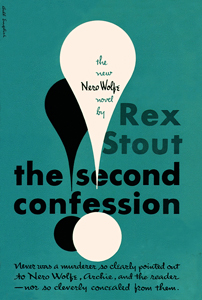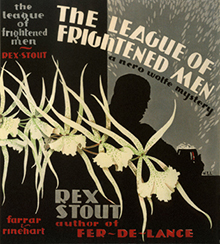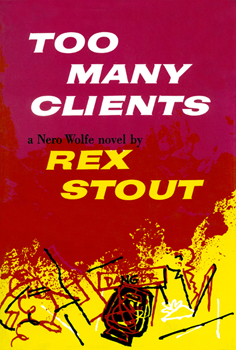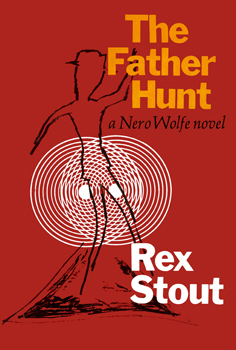
Nero Wolfe is a brilliant, obese and eccentric fictional armchair detective created in 1934 by American mystery writer Rex Stout. Wolfe was born in Montenegro and keeps his past murky. He lives in a luxurious brownstone on West 35th Street in New York City, and he is loath to leave his home for business or anything that would keep him from reading his books, tending his orchids, or eating the gourmet meals prepared by his chef, Fritz Brenner. Archie Goodwin, Wolfe's sharp-witted, dapper young confidential assistant with an eye for attractive women, narrates the cases and does the legwork for the detective genius.

The Silent Speaker is a Nero Wolfe detective novel by Rex Stout, first published by the Viking Press in 1946. It was published just after World War II, and key plot elements reflect the lingering effects of the war: housing shortages and restrictions on consumer goods, including government regulation of prices, featuring the conflict between a federal price regulatory body and a national business association, paralleling the conflicts between the Office of Price Administration and the U.S. Chamber of Commerce and the National Association of Manufacturers.

The Golden Spiders is a Nero Wolfe detective novel by Rex Stout. It was first published in 1953 by The Viking Press.

The Doorbell Rang is a Nero Wolfe detective novel by Rex Stout, first published by the Viking Press in 1965.
Robert Gerald Goldsborough is an American journalist and writer of mystery novels. He worked for 45 years for the Chicago Tribune and Advertising Age, but gained prominence as the author of a series of 17 authorized pastiches of Rex Stout's Nero Wolfe detective stories, published from 1986 to 1994 and from 2012 to 2023. The first novel, Murder in E Minor (1986), received a Nero Award.

Death on Deadline is a Nero Wolfe mystery novel by American writer Robert Goldsborough, first published by Bantam in 1987, the second of Goldsborough's seventeen novels featuring Rex Stout's sedentary detective.
The Nero Wolfe stories are populated by a cast of supporting characters who help sustain the sense that each story takes place in familiar surroundings. The main characters are Nero Wolfe and Archie Goodwin.

The Second Confession is a detective novel by American author Rex Stout, featuring the character Nero Wolfe. The book was first published by the Viking Press in 1949. The story was also collected in other omnibus volumes, including Triple Zeck. This is the second of three Nero Wolfe novels that involve crime boss Arnold Zeck – Wolfe's Professor Moriarty. In this novel he telephones Wolfe to warn him off an investigation and retaliates when Wolfe refuses to cooperate. Though the crime is solved, the ending is left open.

And Be a Villain is a Nero Wolfe detective novel by Rex Stout, first published by the Viking Press in 1948. The story was collected in the omnibus volumes Full House and Triple Zeck.

Some Buried Caesar is a detective novel by American writer Rex Stout, the sixth book featuring his character Nero Wolfe. The story first appeared in abridged form in The American Magazine, under the title "The Red Bull", it was first published as a novel by Farrar & Rinehart in 1939. In 2000 it was included in the list of the 100 Favorite Mysteries of the Century by the Independent Mystery Booksellers Association.

Fer-de-Lance is the first Nero Wolfe detective novel written by Rex Stout, published in 1934 by Farrar & Rinehart, Inc. The novel appeared in abridged form in The American Magazine under the title "Point of Death". The novel was adapted for the 1936 film Meet Nero Wolfe, and it was named after a venomous snake with the same name. In his seminal 1941 work, Murder for Pleasure, crime fiction historian Howard Haycraft included Fer-de-Lance in his definitive list of the most influential works of mystery fiction.

The League of Frightened Men is the second Nero Wolfe detective novel by Rex Stout. The story was serialized in six issues of The Saturday Evening Post under the title The Frightened Men. The novel was published in 1935 by Farrar & Rinehart, Inc. The League of Frightened Men is a Haycraft Queen Cornerstone, one of the most influential works of mystery fiction listed by crime fiction historian Howard Haycraft and Ellery Queen.

Too Many Clients is a Nero Wolfe detective novel by Rex Stout, published by the Viking Press in 1960, and later collected in the omnibus volume Three Aces.

The Final Deduction is a Nero Wolfe detective novel by Rex Stout, published by the Viking Press in 1961 and collected in the omnibus volume Three Aces.

The Mother Hunt is a Nero Wolfe detective novel by Rex Stout, first published by Viking Press in 1963.

The Father Hunt is a Nero Wolfe detective novel by Rex Stout, published by the Viking Press in 1968. "This is the first Nero Wolfe novel in nearly two years," the front flap of the dust jacket reads, "an unusual interval for the productive Rex Stout, who celebrated his eightieth birthday in December 1966."

The Golden Spiders: A Nero Wolfe Mystery is a 2000 American crime drama television film based on the 1953 novel by Rex Stout. Set in 1950s Manhattan, it stars Maury Chaykin as the heavyweight detective genius Nero Wolfe, and Timothy Hutton as Wolfe's assistant, Archie Goodwin, narrator of the Nero Wolfe stories. Veteran screenwriter Paul Monash adapted the novel, and Bill Duke directed. When it first aired on A&E on March 5, 2000, The Golden Spiders was seen in 3.2 million homes, making it the fourth-most-watched A&E original movie ever. Its success led to the A&E original series A Nero Wolfe Mystery (2001–2002).

"Home to Roost" is a Nero Wolfe mystery novella by Rex Stout, first published as "Nero Wolfe and the Communist Killer" in the January 1952 issue of The American Magazine. It first appeared in book form in the short-story collection Triple Jeopardy, published by the Viking Press in 1952. This novella and the 1949 novel The Second Confession are notable expressions of Stout's contempt for both Communism and McCarthyism.

"Bitter End" is the first Nero Wolfe mystery novella by Rex Stout, originally published in the November 1940 issue of The American Magazine. The story is a re-working of Stout's Tecumseh Fox story Bad for Business, published later that year.
The Wolfe Pack is a literary society devoted to Rex Stout's character Nero Wolfe.

















